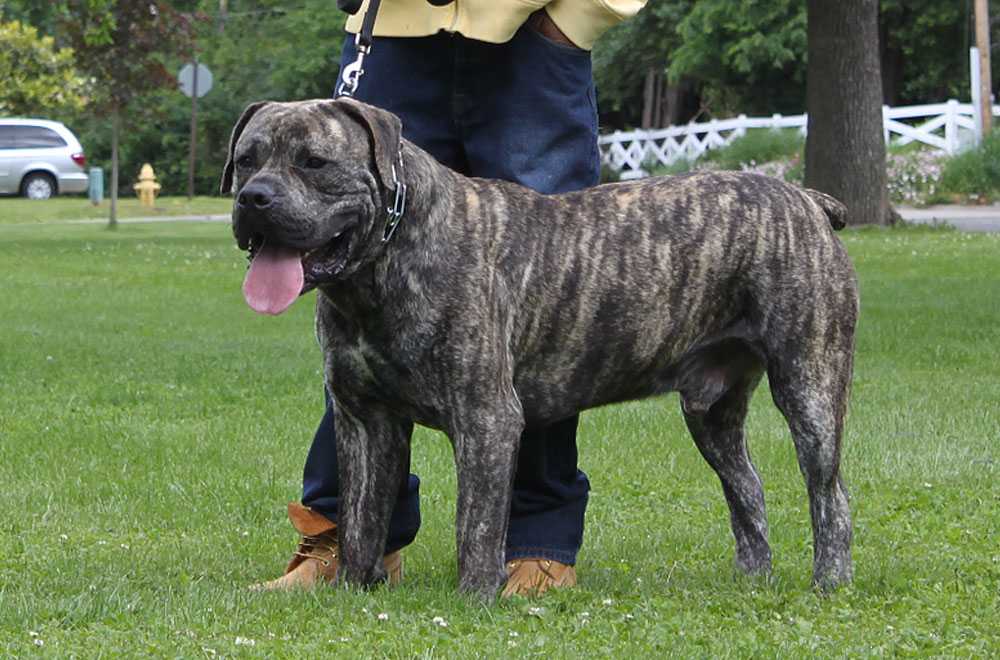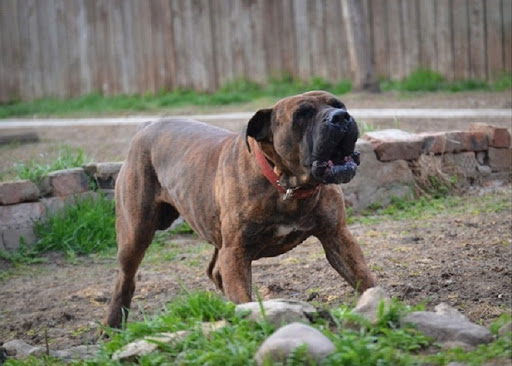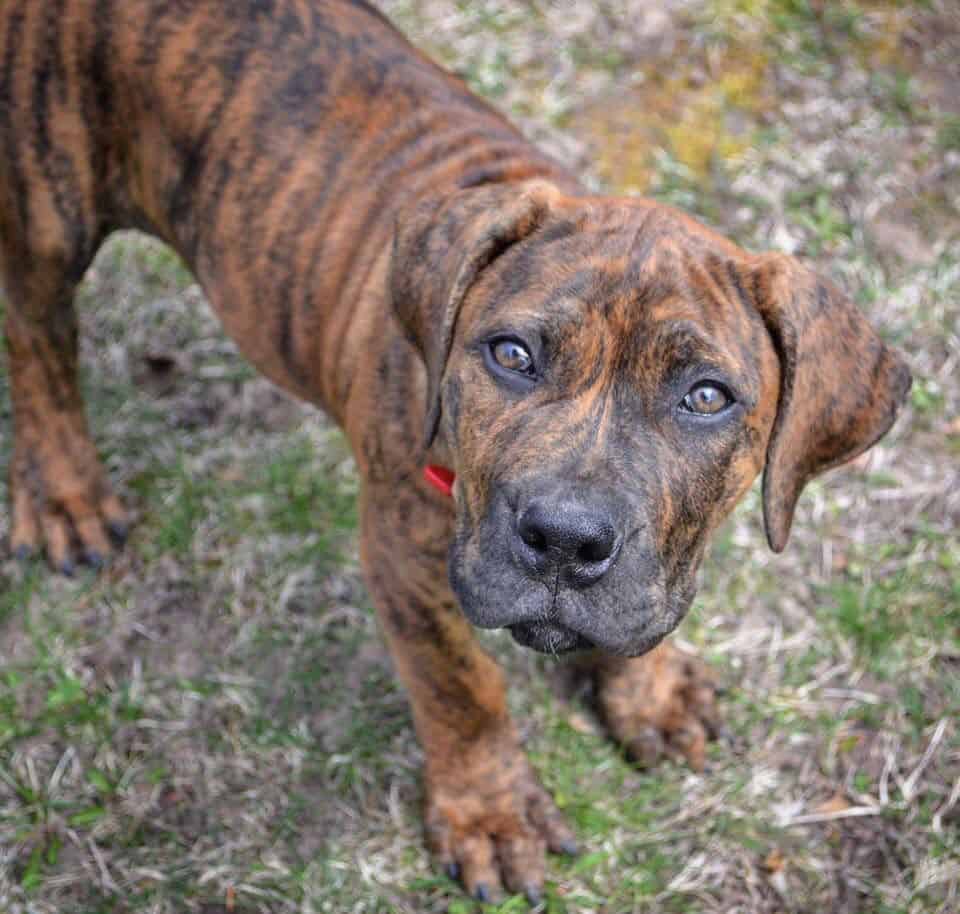Boerboels are gigantic furry friends with so much love for the family.
Also called farmer dogs, Boles, Borbulls, or South African Mastiffs, these dogs were bred in South Africa to protect livestock against attacks from hyenas, lions, and other predators.
Just one look at members of the breed and you know why they were chosen for this job. They are massive, intimidating, confident, and fearless.
On the other hand, Boerboels make the most amazing human companions. They are easy to groom, docile, friendly, loving, kid-friendly, and simply affectionate.
Of course, they have their own cons including chewing, pulling, territorial aggression, and stubbornness, but they sure make great domestic buddies.
If you are looking for this cute and big farmer dog, you have a few options to choose from in terms of color.
Like many breeds out there, boles come in black, fawn, brown, red, and brindle.
In this guide, we will focus on the last option. Here are 7 facts to know before owning a brindle Boerboel.
1. Brindle Boerboels are AKC-recognized

If you are looking to have your doggie participates in the show ring, you’d be happy to know that AKC accepts the color as a breed standard.
The brindle typically features irregular patches of fur featuring a darker color over a lighter background (often red or fawn).
Many brindles are dark but it is not uncommon to have lighter versions as well.
Either way, AKC recognizes and accepts both varieties. Other recognized colors include Tawny, reddish-brown, cream, red, and brown.
As usual, Boerboels may have some white spots on the neck area, paws, and face and dark markings around the mouth, eyes, and nose. Some also have dark markings around the paws.
In case you don’t know, disqualified colors include piebald (a white dog with markings), black (without a hint of brindle), blue, and black with white markings.
2. Brindles Are Rare
In the Boerboel world, brindles come in short supply. Don’t expect to run into brindle Boerboels every day you visit the dog park or take a walk with your doggie.
Shelters and rescue organizations often have fawn, red, brown, and tan South African Mastiffs.
If you are lucky, you will get a few brindles here and there but you might have to traverse states in search of one.
This is something to keep in mind if you don’t have a specific place to buy or adopt from.
The price may also be higher, thanks to the decreased supply and increased demand.
3. Brindle Boels Can Also Be Reverse

Source: 1
As aforementioned, normal brindle Boerboels have dark patterns of hair over a light base color.
Conversely, you may also come across those that have light-colored patterns over a dark background.
You can identify a reverse brindle Boerboel when you glance at a black dog with fawn or tan marks. The marks may be easily visible or faint.
4. Color Is A Result Of A Genetic Mutation
The color of a bridle Boer bull is based on genes that control two color pigments: eumelanin (responsible for black-brown coloring) and pheomelanin (responsible for red-yellow coloring).
The brindle gene must go hand in hand with the agouti gene to create the blend of dark and light furs over the dog’s skin.
The science is a bit complex but the short of it is that different agouti genes combinations determine the appearance of the brindle in a Boerboel.
5. Brindle Boerboels Have A Good Temperament

Anyone that has owned a Boerboel before knows that this is a playful, eager-to-please, and intelligent breed.
Brindle Boels aren’t any different. They thrive well when given a task to carry out, thanks to long years of guarding cattle and sheep.
In the domestic setting, this means putting them up for show ring events to showcase their strength and agility or teaching them to help with simple chores at home.
When it comes to playing with kids, the Boerboel is down for play any time of day.
Of course, this is no playmate for a toddler or a pre-schooler because of the size differences. The pet may be carried away and knock the baby off.
For adults and older kids, expect mad fun outdoors with your doggie.
6. Except When They Are Stubborn
One of the negative sides of owning a brindle Boerboel is that she can be willful and strong.
While an experienced owner may find a way to navigate this, the dog can be overwhelming for a first–time parent.
During training, you have to be firm, sober, assertive, and confident. The minute the pooch notices your weakness, she will pull on the leash and act out just to show you she’s the boss.
You also need a robust, tall fence around the yard to contain her as she can easily take off especially if she sees another mastiff dog ready to fight with him.
All in all, this is a great pet to own if you’ve handled other dogs before. If not, determine if you can deal with the bad side of owning one beforehand.
7. Brindling Can Affect The Health Of The Boerboel

The brindle gene in itself may not have much effect on the health of a dog.
However, if it mixes with other coat color genes, it can result in health problems. A good example is the merle gene which has been known to cause eye and ear problems in canines.
Merle can combine with brindle with the result being a very attractive doggie. However, the pet may not do very well in the health department.
The Boerboel is generally a very healthy dog. Unless the brindle mixes up with other color genes, the color will not affect health in any way.
Watch out for elbow dysplasia, bloat, heart disease, and vaginal hyperplasia – the few common issues with big dog breeds.
Parting Thoughts
There it is – the facts to know before owning a brindle Boerboel.
The breed is no doubt a beautiful, rare, low-maintenance, healthy, and well-tempered pet.
On the flip side, she possesses the same bad qualities as other Boerboels including stubbornness, tendency to jump over the fence, and training challenges.
Take your pick.
As an Amazon Associate, we may receive a small commission from qualifying purchases but at no extra cost to you. Learn more. Amazon and the Amazon logo are trademarks of Amazon.com, Inc, or its affiliates.

